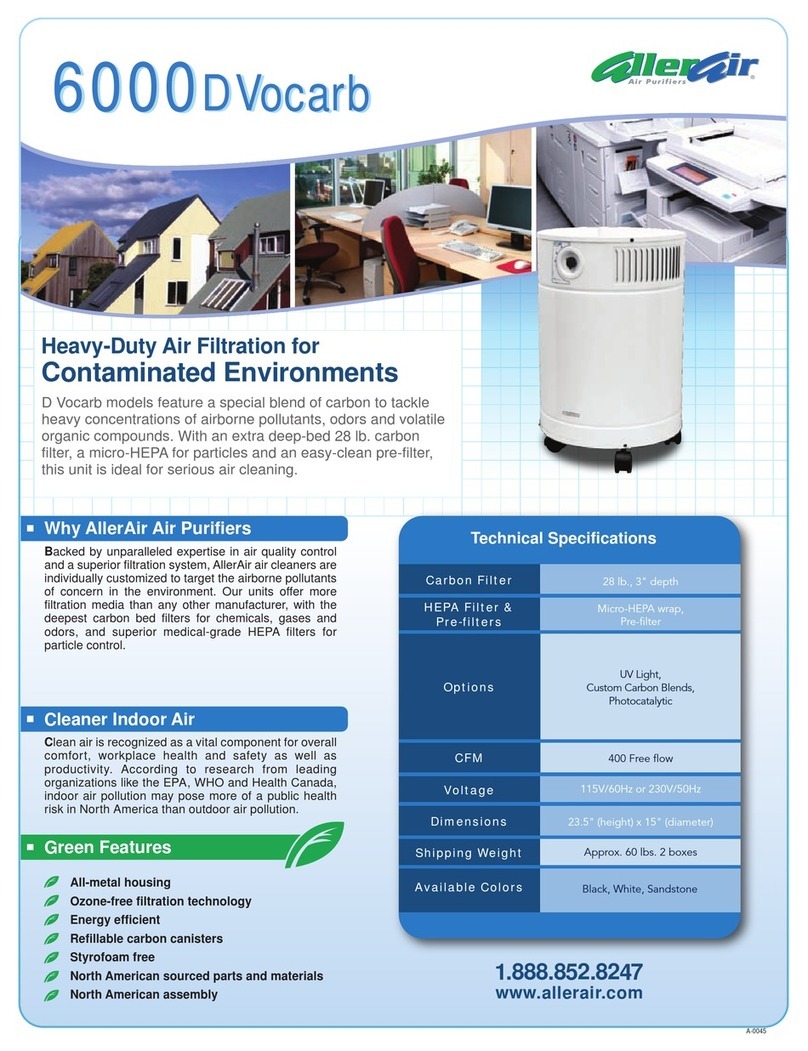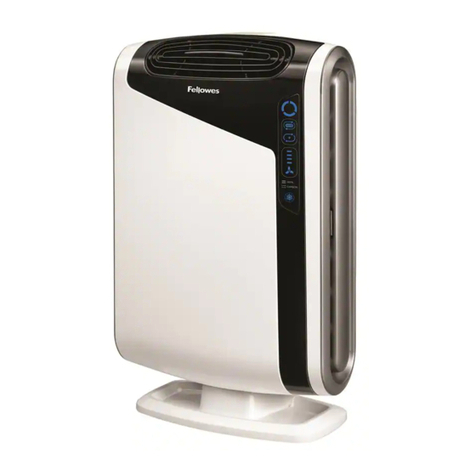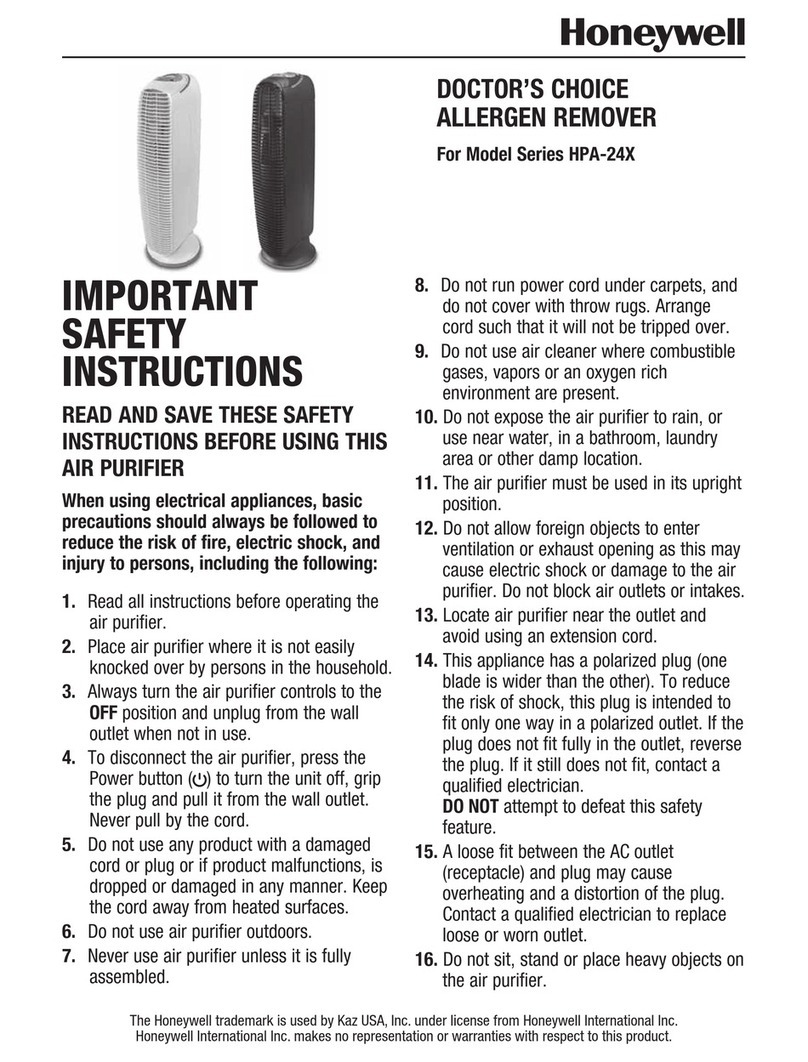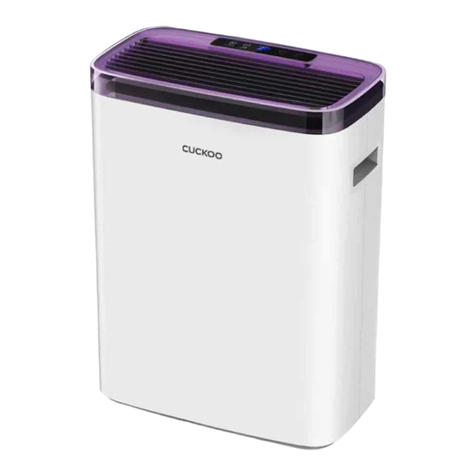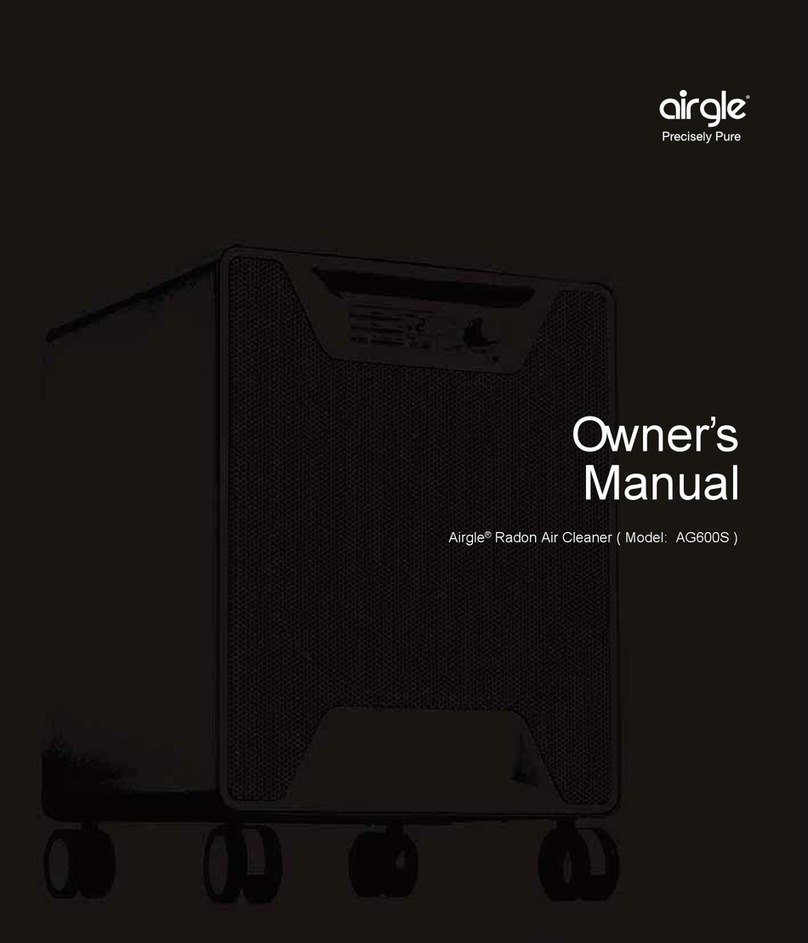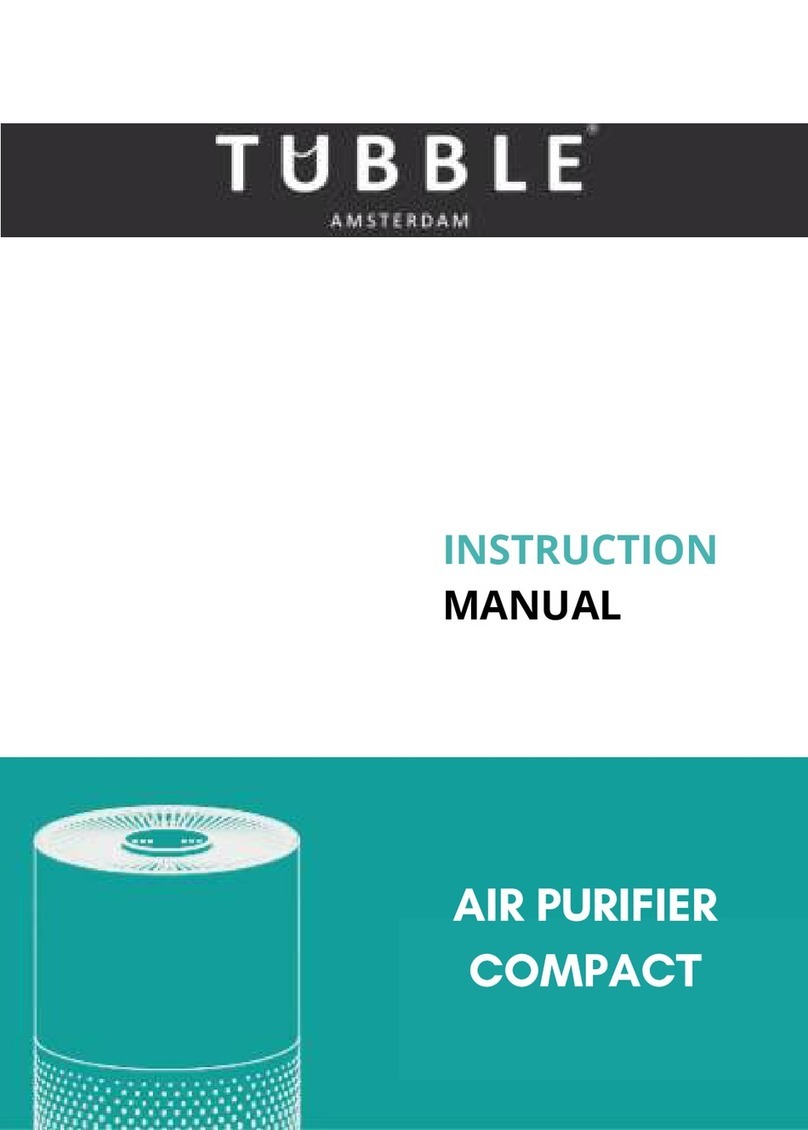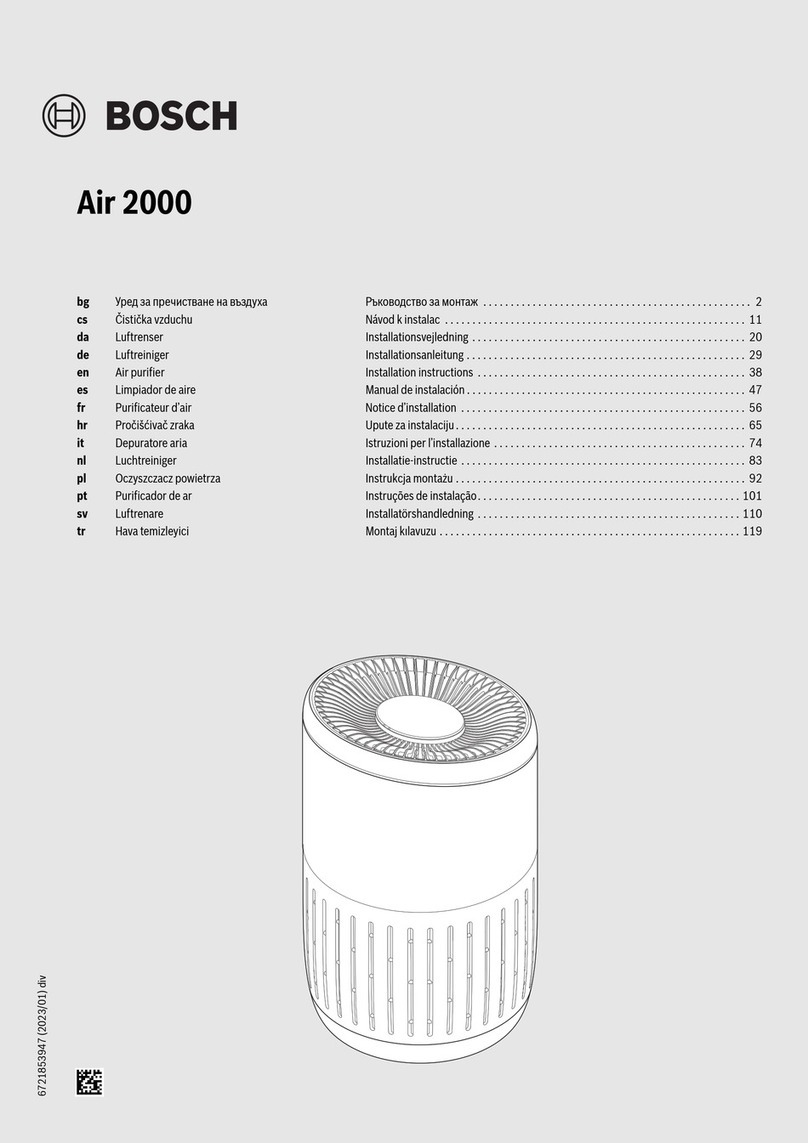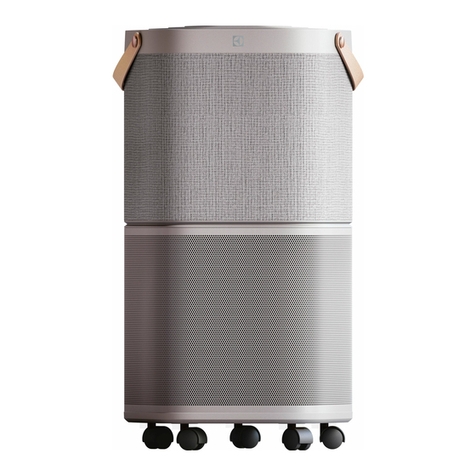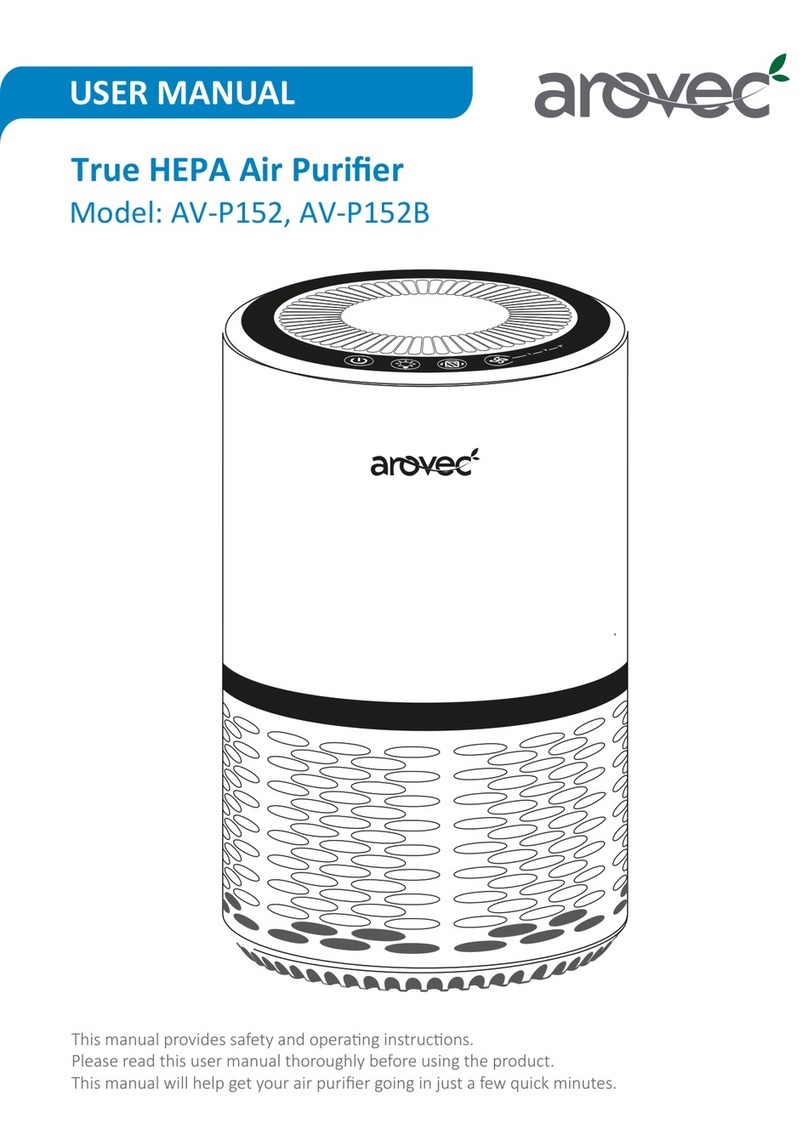Healthy Climate HEPA Bypass Air Filtration Systems HEPA-20 User manual

INDOOR AIR QUALITY
KIT AND ACCESSORIES
504887-01
10/2021
Supersedes 3/2021
HEALTHY CLIMATE®
HEPA BYPASS AIR FILTRATION
SYSTEM
INSTALLATION INSTRUCTIONS AND HOMEOWNER GUIDE FOR HEALTHY CLIMATE®
MODELS HEPA-20, HEPA-40 and HEPA-60
WARNING
Improper installation, adjustment, alteration, service or
maintenance can cause property damage, personal injury
or loss of life.
Installation and service must be performed by a licensed
professional HVAC installer (or equivalent) or a service
agency.
Rules for Safe Installation and Operation
Please read instructions before installing and using the
HEPA Bypass Air Filtration System (HEPA system). This
will help you obtain the full benet of the HEPA system you
have selected. It will also help you to avoid needless ser-
vice costs.
1. Read this manual carefully. Failure to follow these rules
and instructions could cause a malfunction of air filter
or unsatisfactory service and could void your warranty.
2. Follow a regular service and maintenance schedule
to ensure ecient operation.
3. For safety and optimized performance of your HEPA
system, all installation and maintenance must be
performed by a Healthy Climate®dealer. The installer
should be made aware of your indoor air quality
situation and be familiar with your heating, ventilation
and air conditioning equipment.
4. Remove HEPA cartridge packing materials before initial
start-up of this product.
a. Remove safety screws from HEPA lter access
panel.
b. Unlatch the four retaining clips and lift o HEPA lter
access panel.
c. Remove and discard the cardboard packing material
between the HEPA cartridge and the lter access
panel.
d. Ensure HEPA cartridge is installed and locked into
place (brace the unit, press HEPA cartridge down
and turn it clockwise to lock it into place.)
e. Replace the HEPA lter access panel and latch it
with the four retaining clips.
f. Re-install safety screws into HEPA lter access
panel.
5. High particulate distribution may occur during initial
start-up of this product after installation or after
scheduled lter changes. Individuals who are highly
sensitive to airborne particulates should not be in the
building and allow 24 hours of operation for removal of
particulates from occupied spaces before re-entry.
Shipping and Packing List
Package 1 of 1 contains:
1 - HEPA System
1 - Complete Filter Set (Packed inside Unit)
1 - Warranty Certicate
1 - Installation Instructions (this manual)
HEPA System Models
HEPA-20 (X4912) is designed to lter air up to a rate of
180 cfm
HEPA-40 (X4913) is designed to lter air up to a rate of
320 cfm
HEPA-60 (X4914) is designed to lter air up to a rate of
660 cfm
WARNING
Improper installation, adjustment, alteration, service or
maintenance can cause property damage, personal injury
or loss of life.
Installation and service must be performed by a licensed
professional HVAC installer (or equivalent) or a service
agency.
WARNING
Electric Shock Hazard. Can cause injury or death. Unit
must be rounded in accordance with national and local
codes.
Line voltage is present at all components when unit is
not in operation. Disconnect all remote electric power
supplies before opening access panel. Unit may have
multiple power sources.
WARNING
Risk of Carbon Monoxide Poisoning.
Can cause injury or death.
Do not operate equipment without access panel in place.
Operation of this equipment without all access panels in
place may cause gas fumes from the heating system to
be drawn into occupied spaces.

2
Introduction
Congratulations! You will quickly realize that you have pur-
chased a very eective air cleaning system. It incorporates
state of the art HEPA (High Eciency Particulate Air) tech-
nology.
Your HEPA system comes with a limited warranty. With
proper attention to its care and maintenance, you will re-
ceive optimum performance.
If your indoor air has abnormally high concentrations of par-
ticulates, the life span of the lter media may be shortened.
Excessive particulates in the air will reduce the expected
life of the HEPA lter. Under normal conditions the HEPA
lter will last from two to ve years.
The optional activated carbon canister has a nite limit as to
the amount of odor or other gaseous volatile organic com-
pounds (VOCs) that it can adsorb. The higher the concen-
trations, the shorter the expected life. Higher humidity may
shorten the life of the carbon canister. Under normal condi-
tions, the carbon canister will last up to 6 months.
Initially, the HEPA lter’s particulate removal eciency im-
proves with use. However, the air ow through the HEPA
lter media will decrease, as dust builds up on the lter,
thus lowering its ability to circulate and clean as much air
as when it was new. If the air ow through your unit is no-
ticeably reduced, you can inspect the carbon pre-lter and
HEPA lter to see if they should be replaced. Replacement
of the carbon pre-lter every 12 months will help extend the
life of the HEPA lter.
Please contact your local Healthy Climate dealer regarding
replacement of lters, warranty information or if you have
any questions or concerns about the performance of your
HEPA system.
NOTE: This ltration system is an ADDITIONAL
lter, and does NOT replace the existing air
handler/furnace system lter.
To signicantly increase the quality of air in your home,
bringing in FRESH AIR is strongly recommended. Filtering
outdoor air with a HEPA/Carbon lter will remove many of
the containments and irritants from outdoor air.
The HEPA Air Filtration System when used with the LVCS
or HRV/ERV and Dehumidiers will lter ultra-ne particu-
lates, chemicals, odors and other toxins out of the new air
entering the home. Bringing in fresh air that is clean and
ltered will increase the quality of the air in the home. Slight
positive pressurization of the home will prevent unwanted
containments from walls and attics sneaking in! Ask your
Healthy Climate Dealer about installing a system that will
introduce fresh air. “Service and Application Note IAQ-06-
2”.
General Information
Media Filters
Media lters strain particulates from the air. The lter media
needs to have tiny holes to allow air to pass through, but not
particulates. Filter types vary for all sorts of purposes. The
most eective and proven lter media is HEPA. HEPA lter
media is 99.97% ecient at capturing particles which are
0.3 micron in size or larger.
Inner Charcoal Filter/Carbon Canister
Carbon media is used to capture chemicals and odors,
also referred to as VOCs. Chemicals and odors cannot be
captured with media type lters. Activated carbon attracts
chemicals and odors and holds them. If air passes through
the carbon lter before particulates are removed, the sur-
face of the carbon quickly gets covered with particulates,
rendering it ineective at capturing chemicals and odors. If
particulates are removed from the air with a HEPA lter, vir-
tually the entire surface area of the carbon can be used to
capture chemicals and odors. This increases the eciency
and lter life of the inner charcoal lter.
Separate HEPA and Carbon Filters
HEPA and carbon lters have dierent life spans. It is im-
portant for a ltration system to keep the lter components
independent from each other, so that the lter that is dirty/
saturated can be changed. This is more economical than
a system where you need to throw out two or three lters
when only one needs changing.
The HEPA System’s 3 Stage Filtration Process
The 3 stage ltration process is used to create a very eec-
tive ltration system. Each lter is independent and can be
changed individually.
• Stage 1: Carbon pre-lter - The inexpensive carbon
pre-lter removes larger particulates from the air, thus
prolonging the life of the HEPA lter.
• Stage 2: HEPA - The HEPA lter removes 99.97% of
particulates 0.3 micron and larger. The cleaned air then
passes through the third stage lter.
• Stage 3: Inner Charcoal Filter - The inner charcoal lter
is 1/2 an inch thick to give it plenty of surface area for
removing chemicals and odors from the air.
OPTIONAL UPGRADE: The stage 3 Inner Carbon Filter
may be replaced by an optional heavy duty granulated co-
conut shell carbon canister. The VOC Canister oers in-
creased capacity removal of chemicals and odors. Filled
with granulated coconut shell carbon, the surface area
available for adsorption of gas and chemical pollution is
approximately 60 to 70 million square feet. The lter up-
grade captures many containments in the air and holds
them safely in the carbon. The increased capacity of this
lter also extends the performance life. The VOC Canister
also captures low level ozone from outside air and uses the
ozone to turn the lter into an active system which actually
destroys VOCs rather than just holding them.
Product Application Guidelines
Notes:
• Industry experience indicates that one (1) air change
per hour generally provides adequate air cleaning. Ac-
tual results will depend on multiple factors such as out-
door particulate levels, inltration rate, indoor activities
etc.
• The chart is based on an inltration rate of 0.3 air chang-
es per hour, which is typical for residential construction.
Higher inltration typically brings in more particulates
and thus increases the air changes per hour needed for

3
HEPA bypass ltration. Other particulate sources in the
house will require higher air changes per hour.
• The chart is based on continuous operation of the HEPA
system. If the HEPA system is cycled, the capacity of
the lter needs to be increased. For example, if the
HEPA system is “ON” only half the time, then the capac-
ity of the unit needs be doubled or additional units need
to be installed.
• The more air changes per hour provided, the more ef-
fective a HEPA system will be. People with sensitivities
may desire a higher number of air changes per hour for
cleaner air.
Table 1. Size of House versus Air Changes Per Hour
Size of House*
Model 1,000 ft2 1,200 ft2 1,500 ft2 1,800 ft2 2,000 ft2 2,500 ft2 3,000 ft2 3,500 ft2
Unit (8,000 ft3) (9,600 ft3) (12,00 ft3) (14,400 ft3) (16,000 ft3) (20,000 ft3) (24,000 ft3) (28,000 ft3)
HEPA-20 1.35 1.13 0.9 -- -- -- -- --
HEPA-40 2.4 2.0 1.6 1.3 1.2 1.0 -- --
HEPA-60 5.0 4.1 3.3 2.8 2.5 2.0 1.7 1.4
*Chart based on homes with 8 ft. ceilings.
Parts Identication
Filter Section Access
Panel
Retaining Clips (4)
Inlet Collar
Cabinet
Outlet Collar
On/Off Switch
Motor Section
Access Panel
Figure 1. Cabinet Parts
HEPA Filter
(STAGE 2)
Carbon Pre-Filter
(STAGE 1)
HEPA Filter Mesh
(Protects HEPA
Filter)
Inner Charcoal Filter
(STAGE 3)
Figure 2. HEPA Cartridge Parts
Motor/Impeller
Filter Adapter
(threaded)
‘O’ Ring
Figure 3. Inside Cabinet (Filter Section)
RECOMMENDED for
greater capacity removal
of chemicals and odors.
Located inside the HEPA
filter cartrige to provide
the third and final stage of
filtration.
Replace inner charcoal
filter when using the
optional carbon canister.
Figure 4. Optional Coconut Shell Carbon Canister
Specications
Table 2. Specications
HEPA-20 HEPA-40 HEPA-60
Nom. Air Flow @ 120VAC @ 0.0” E.S.P. 180 cfm 320 cfm 660 cfm
Weight (max - unpackaged) 30 lbs. 44 lbs. 49 lbs.
Supply Voltage 120 VAC 120 VAC 120 VAC
Nom. Measured Power Consumption 125 Watts 125 Watts 225 Watts
Motor Current Draw 1.0 amps,
60hz
1.0 amps,
60hz
1.8 amps,
60hz
Air Inlet Collar (max) 8”-round 10”-round 10”-round
Air Outlet Collar (max) 6”-round 8”-round 8”-round
Operating Temp. Range - Return air (ºF) 30 to 95 30 to 95 30 to 95
HEPA lter eciency = 99.97% @ 0.3 micron particles
Ambient temperature range: -40ºF to 130ºF

4
Unit Dimensions
A
B
C
D
Air Inlet
Air Outlet
1 (25)
A
E
Power
Switch
Figure 5. Unit Dimensions
Model No. A B C D E
in. mm in. mm in. mm in. mm in. mm
HEPA-20 14 356 17-7/8 454 8 203 6 152 1 25
HEPA-40
HEPA-60 16-1/8 410 28 711 10 254 8 203 1-3/4 44
Operation
1. Make sure that the unit is plugged into a grounded outlet
(120 Volt, 60 Hz).
2. For optimum performance, the HEPA system should
operate when the indoor air handler/furnace blower is
on. An optional air handler/furnace blower interlock
kit can be ordered for ‘cycled’ operation. (see
Replacement Parts)
3. Turn the unit on by pressing the on/o switch to the ‘1’
position. The switch should light up when the unit is
on.
4. To turn the unit o, press the on/o switch to the ‘0’
position. The switch light should turn o when the unit
is o.
Maintenance
CAUTION
Risk of Sharp Edges Hazard.
Equipment sharp edges can cause injuries.
Avoid grasping equipment edges without protective
gloves.
Proper care and maintenance of your HEPA system will en-
sure years of service. The unit must be turned o during
service/maintenance or when lters are being changed.
It is recommended that gloves and a ltered breathing mask
be worn during lter replacement.
Filter Change Schedule
NOTE: Failure to properly maintain your HEPA system will
decrease the eciency and air ow.
For enhanced odor control, the Coconut Shell Carbon Can-
ister provides up to one year of odor capture.
Table 3. Filter Replacement Schedule
Replacement Part HEPA-20 HEPA-40 HEPA-60 Replacement
HEPA Filter Cartridge
w/O-Ring 92X17 92X10 92X10 2 to 5 years
Carbon Pre-Filter X4137 X4138 X4138 12 months
Inner Charcoal Filter X2678 92X09 92X09 3 months
Carbon Canister
(Optional) 94X98 98X75 98X75 1 year
NOTE: Filter life is based on average air content. Some
lters may need to be changed more often due
to higher amounts of dust, humidity, or chemicals
found in your ambient air. Additionally, people who
are more sensitive to these air borne contaminates
may desire more frequent lter changes.
Filter Changing Guidelines
Carbon Pre-Filter:
Dust and other large particles will collect on the carbon
pre-lter over time. The color of the lter will change as
particulates build up on the carbon pre-lter. Change the
carbon pre-lter when you can see the particulate build up
start to clog up the carbon pre-lter.
HEPA Filter:
As the HEPA lter captures particulates, it will darken over
time. Replace the HEPA lter when it darkens to the level
seen in example D.
A. New B. Used C. Used D. Replace
Figure 6. HEPA Filter Color

5
Inner Charcoal Filter
The inner charcoal lter will rarely look used. This lter cap-
tures odors and gases, yet the lter’s appearance will not
change. When this lter has reached it’s maximum absor-
bency of odors and gases, it will no longer work. Replace
this lter when it no longer seems to capture odors, at least
every 3 months, whichever occurs rst.
Carbon Pre-Filter
HEPA Filter
Inner Charcoal Filter
Optional Coconut Shell
Carbon Canister
replaces Inner Charcoal Filter
Figure 7. Inner Charcoal Filter
Dealer Filter Change Instructions
It is recommended that gloves and a ltered breathing
mask be worn during lter replacement to avoid breathing
particulates (dust, mold, pollen, etc.) captured on the lter
that become airborne during the lter(s) change out.
The old lters should be wrapped and sealed in plastic bags
immediately upon removal from the unit to avoid distribut-
ing particles throughout the house during the process of
disposal.
1. Accessing the filters
a. Remove safety screws from HEPA lter access
panel.
b. Unlatch the four retaining clips and lift o HEPA
lter access panel.
c. Bracing the unit so it does not move, turn the
HEPA cartridge counter-clockwise and lift out.
2. Carbon Pre-Filter Replacement
a. Locate the clips holding the carbon pre-lter in place.
Remove them and pull the carbon pre-lter o.
NOTE: The carbon pre-lter may contain contaminants,
remove it slowly to avoid releasing particles back
into the air.
b. Remove plastic shrink wrap from the new carbon
pre-lter.
c. Wrap the new carbon pre-lter around the HEPA
lter, making sure that the ends overlap.
d. Hook one end of the clip onto the overlapping
section of carbon pre-lter as shown in gure 13.
e. Press down on the hooked section while you pull it
across, stretching the carbon pre-lter tighter as
shown in gure 14.
f. Push down on the other end of the clip once the
carbon pre-lter is stretched tight to lock the clip
into place as shown in gure 15. Release clip, it
should hold tight on both ends of the carbon pre-
lter keeping it together.
g. Repeat steps d through f with the other clips,
spacing them evenly on the carbon pre-lter to
give it even support.
3. Inner Charcoal Filter Replacement
a. Look inside the HEPA cartridge to locate the two
ends of the inner charcoal lter.
b. Pull one end of the old inner charcoal lter in and
bend it into a loose roll so it can be removed.
c. Remove the inner charcoal lter from the HEPA
cartridge.
d. Remove plastic shrink wrap from the new inner
charcoal lter.
e. Unroll the inner charcoal lter and roll it up in the
opposite direction (this makes the lter follow a
more contoured prole against the inner HEPA
lter surfaces and helps keep it in place), place
the rolled inner charcoal lter inside the HEPA
cartridge and gently unroll it until the ends ‘butt’
together and the lter is snug against the HEPA
lter mesh.
4. HEPA Filter Replacement
a. If replacing the HEPA lter with a new lter, discard
old HEPA lter and use new when replacing the
HEPA lter into the unit.
b. With each HEPA replacement lter, a new ‘o’ ring
is provided. The old one is removed by pinching it
between two ngers and pulling it o the collar on
the blower deck.
c. Discard old ‘o’ ring.
d. Place the new ‘o’ ring onto the collar and slide it
down to the base of the blower deck.
Figure 8. Step 1

6
Figure 9. Step 2
Figure 10. Step 3
5. Optional Coconut Shell Carbon Canister
a. Remove old carbon canister (if installed) by pulling it
out from the inside of the HEPA lter.
b. If replacing an inner charcoal lter with the carbon
canister, remove inner charcoal lter by following
the steps a. to c. in section 3.
c. Remove the plastic shrink wrap from the new carbon
canister.
d. Slide the carbon canister into the HEPA cartridge,
smaller, tapered end rst. The carbon canister
should slide all the way in until the metal edges at
the base meet the HEPA lter.
e. Support the carbon canister with your ngers
so it does not slide out when replacing the HEPA
cartridge assembly into the unit.
6. Installing the HEPA Filter Cartridge
a. With the lters changed or inspected, all 3 lters
are ready to be placed back into the unit. Place
the HEPA cartridge gently into the unit (if a carbon
canister is being used, take care not to let it slide out
as it is heavy and could damage the unit)
b. When the HEPA cartridge is in place, brace the unit,
press down and turn it clockwise to lock it into place.
c. Replace the HEPA lter access panel and latch it
with the four retaining clips.
d. Re-install safety screws into HEPA lter access
panel.
e. Plug the unit back into a power outlet and turn it on.
Dealer Motor Assembly Replacement
Instructions
1. Accessing the motor assembly
a. Turn the unit o and unplug it from any electrical
source before opening the cabinet.
b. To remove the motor section access panel, remove
the four screws on the panel, and lift o panel.
2. Removing the old motor assembly
a. Disconnect all four motor wires from switch, ground
post and capacitor.
b. Disconnect the two white wires from the capacitor.
c. Separate the motor from the motor mount by
removing the four screws found in gure 16.
d. Slide the motor out from under the motor mount
to remove it from the unit.
3. Installing the new motor assembly
a. Slide the new motor into the motor mount making
sure that the wires go through the smaller hole
oset from the center of the bracket.
b. Secure the new motor to the motor mount with the
four screws removed in step 2c.
c. Connect the wires as follows:
»Blue wire from motor to the on/o switch.
»Yellow/green wire from motor to the ground post.
»Brown wire from the motor to a capacitor post.
»Black wire from the motor to the other capacitor
post.
» White wire from the on/o switch to the capacitor
via the black wire piggyback post.
»White wire from the power cord to the capacitor
via the other white wire’s piggyback post.
4. Closing the unit
a. Replace the motor section access panel and
secure it with the eight screws removed in step 1b.
b. Plug the unit into it’s electrical source and turn it on.
Figure 11. Closing the Unit

7
Dealer Installation Instructions
Forced Air Handler/Furnace Systems
The HEPA system should be installed as a bypass system,
with part of the return ducted into the HEPA system.
The ltered air is then rerouted back into the return air, and
continues through the system to be heated/cooled.
Typical Return to Return Application (Upow)
For homes with up-ow forced air handler/furnace systems.
(Air handler/furnace is shown in a typical basement.
Distance
between A and
B should be 8’
to 16’ for best
Air Handler /
Furnance
Air Handler /
Furnace Filter
HEPA
System
A
B
Figure 12. Typical Return to Return Application
(Uplfow)
Typical Return to Return Application
For homes with horizontal forced air handler/furnace
systems. (Air handler/furnace is shown in an typical attic.
Air Handler/
Furnace
Air Handler/
Furnace Filter
HEPA System
A
B
Distance between A and B should
be 8’ to 16’ for best results.
Figure 13. Typical Return to Return Application
(Horizontal)
NOTE: This ltration system is an ADDITIONAL lter, and
does NOT replace the existing air handler/furnace
system lter.
Preparation
Here are some things to consider as you decide where to
install the HEPA system.
1. Location:
»Make sure there is room to open the HEPA lter ac-
cess panel for lter changes/inspections.
»Keep the HEPA system in a location where you can
still access the air handler/furnace lter.
»Keep the HEPA system away from possible water
damage.
»Vibration pads will reduce vibration for installations
where the unit is placed on the oor.
»Install HEPA System on oor or suspended platform.
If the unit is suspended, screws must not penetrate
through the cabinet. Make sure that you have the
proper chains/straps/joists and equipment to keep
unit secure.
2. Inlet (Marked as ‘Air In’ on unit):
»Inlet ducts should be installed upstream of any hu-
midiers and be installed on the main return.
»Inlet duct should be installed at least 8 ft. away from
the outlet duct on the main return.
»Use a 45 degree takeo to draw air from the main
return.
3. Outlet (Marked as ‘Clean Air Out’ on unit):
»Outlet duct should be installed as close to the air
handler/furnace inlet as possible but not directly into
the return air elbow of the main return.
»To reduce static pressure, install outlet with a 45
degree takeo directly up-line from the return air el-
bow.
»If the unit is being installed independently of any oth-
er system, room diusers are recommended to help
distribute airow evenly in the occupied space.
4. Ducting
»If HEPA system is installed where inlet and outlet
collars face down, metal elbows must be connected
to both inlet and outlet collars.
»Each connection must be sealed with aluminum
tape or mastic, including all take os.
»Installed duct runs should be as straight as possi-
ble (if the duct runs are too long, reduced CFM may
result).
»If duct is exposed to unconditioned air, externally in-
sulated ex duct is highly recommended.
»Externally insulated ex duct can also be used for
noise reduction purposes
»For best indoor air quality, do not use duct-board or
berglass inside of ducts.
5. Electricity
The unit must be plugged into a grounded 120V, 60Hz out-
let.
Required Materials for Installation of Unit:
1. For Model: HEPA-20
»8” diameter ex or rigid duct (as required)
»6” diameter ex or rigid duct (as required)
»8” diameter 45 degree takeo
»6” diameter 45 degree takeo
»Aluminum tape or mastic
»Miscellaneous hanging materials - eld provided
2. For Models: HEPA-40 and HEPA-60
»10” diameter ex or rigid duct (as required)
»8” diameter ex or rigid duct (as required)
»10” diameter 45 degree takeo
»8” diameter 45 degree takeo

8
»Aluminum tape or mastic
»Miscellaneous hanging materials - eld provided
NOTE: Be sure to review ‘Rules for Safe Installation and
Operation’ on page 1 of this document before
start-up of this unit.
Forced Air Handler/Furnace System with an HRV/ERV
Forced air handler/furnace system with an HRV/ERV This
application provides ltration of all Outdoor Air (OA) that is
brought into the home through the HRV/ERV, thus reducing
the introduction of dust, pollen and mold from the outdoor
air. For systems that have HRV/ERV units installed, we
recommend ducting the ‘fresh air’ outlet from the HRV/ERV
into the HEPA system. If the HRV/ERV CFM (cubic feet
per minute) rating is lower than that of the HEPA system,
an additional return needs to be installed into the HEPA
system.
The output air from the HEPA system then needs to be
installed into the main return of the air handler/furnace
system.
Example of Return to Return Installation with HRV/
ERV
For homes with a forced air handler/furnace system and an
HRV/ERV system.
Additional Return
Air Handler / Furnace
Air Handler / Furnace Filter
HEPA System
HRV /
ERV
Figure 14. Typical Return to Return Application
(HRV/ERV)
NOTE: This ltration system is an ADDITIONAL lter, and
does NOT replace the existing air handler/furnace
system lter.
Preparation
Here are some things to consider as you decide where to
install the HEPA system with an HRV/ERV.
1. Location:
»Make sure there is room to open the HEPA lter ac-
cess panel for lter changes/inspections.
»Keep the HEPA system in a location where you can
still access the air handler/furnace lter.
»Keep the HEPA system away from possible water
damage
»Vibration pads will reduce vibration for installations
where the unit is placed on the oor.
»Install HEPA System on oor or suspended platform.
If the unit is suspended, screws must not penetrate
through the cabinet. Make sure that you have the
proper chains/straps/joists and equipment to keep
unit secure.
2. Inlet (Marked as ‘Air In’ on unit):
»Most HRV/ERV systems will not move as much air
as the HEPA system. For these systems, install an
additional return from another treated air source into
the HEPA system.
»If using an additional return duct, it should be in-
stalled upstream of any humidiers. The fresh air
outlet of the HRV/ERV should be “Y” connected to
the additional return duct then connected to the inlet
of the HEPA system.
»The additional return duct (if any) should be installed
at least 8 ft. away from the outlet duct on the main
return.
»Duct both the HRV/ERV and the additional return
into the inlet of the HEPA system.
3. Outlet (Marked as ‘Clean Air Out’ on unit):
»Outlet duct should be installed as close to the air
handler/furnace inlet as possible but not directly into
the return air elbow of the main return.
»To reduce static pressure, install outlet with a 45 de-
gree takeo directly up-line from the return air elbow
of air handler/furnace.
4. Ducting
»If HEPA system is installed where inlet and outlet
collars face down, metal elbows must be connected
to both inlet and outlet collars.
»Each connection must be sealed with aluminum
tape or mastic, including all take os.
»Installed duct runs should be as straight as possi-
ble (if the duct runs are too long, reduced CFM may
result).
»If duct is exposed to unconditioned air, externally in-
sulated ex duct is highly recommended.
»Externally insulated ex duct can also be used for
noise reduction purposes
»For best indoor air quality, do not use duct-board or
berglass inside of ducts.
5. Electricity
The unit must be plugged into a grounded 120V, 60Hz out-
let.
Required Materials for Installation of Unit:
1. For Model: HEPA-20
»8” diameter ex or rigid duct (as required)
»6” diameter ex or rigid duct (as required)
»6” diameter 45 degree takeo
»Aluminum tape or mastic
»Miscellaneous hanging materials - eld provided
2. For Models: HEPA-40 and HEPA-60
»10” diameter ex or rigid duct (as required)
»8” diameter ex or rigid duct (as required)

9
»10” diameter 45 degree takeo
»8” diameter 45 degree takeo
»Aluminum tape or mastic
»Miscellaneous hanging materials - eld provided
Dealer Installation Instruction - Independent
Operation
The HEPA systems can be used independently of any other
equipment! The inlet and outlet of the ltration system can
be ducted into the same room to create a cleaner environ-
ment almost anywhere. The inlet or outlet can also be duct-
ed elsewhere. The inlet and outlet should be installed on
opposite sides of the room; however, this varies according
to your specic needs.
Example of Single Room Stand Alone System
Installation
For single rooms where increased ltration is desired such
as a dedicated ‘smoking room’.
HEPA System
A
B
Air should be drawn from
location B if space is
available, otherwise, use
location A.
Figure 15. Typical Single Room Stand Alone System
Preparations
Here are some things to consider as you decide where to
install the HEPA system independently of other systems.
1. Location:
»Make sure there is room to open the HEPA lter ac-
cess panel for lter changes/inspections.
»Keep the HEPA system away from possible water
damage.
»Vibration pads will reduce vibration for installations
where the unit is placed on the oor.
»Install HEPA System on oor or suspended platform.
If the unit is suspended, screws must not penetrate
through the cabinet. Make sure that you have the
proper chains/straps/joists and equipment to keep
unit secure.
2. Inlet (Marked as ‘Air In’ on unit):
»Inlet ducts should be installed near the oor for opti-
mum airow (see gure 11). If space does not allow,
then the inlet can be installed in the ceiling.
»Inlet duct should be installed at least 8 ft. away from
the outlet duct on the main return.
»Inlet duct should be installed at opposite end of the
room from the outlet duct(s) if in the same room.
»Diusers are recommended to help distribute airow
evenly.
3. Outlet (Marked as ‘Clean Air Out’ on unit):
»Outlet(s) should be installed in the ceiling away from
any other air inlet(s)
»Room diusers are recommended to help distribute
airow evenly in the occupied space.
4. Ducting
»If HEPA system is installed where inlet and outlet
collars face down, metal elbows must be connected
to both inlet and outlet collars.
»Each connection must be sealed with aluminum
tape or mastic, including all vent connections.
»Installed duct runs should be as straight as possi-
ble (if the duct runs are too long, reduced CFM may
result).
»If duct is exposed to unconditioned air, insulated ex
duct is highly recommended.
»Externally insulated ex duct can also be used for
noise reduction purposes
»For best indoor air quality, do not use ductboard or
berglass inside of ducts.
5. Electricity
The unit must be plugged into a grounded 120V, 60Hz. out-
let.
Required Materials for Installation of Unit:
1. For Model: HEPA-20
»8” diameter ex or rigid duct (as required)
»6” diameter ex or rigid duct (as required)
»8” diameter vent
»6” diameter vent
»Aluminum tape or mastic
»Miscellaneous hanging materials - eld provided
2. For Models: HEPA-40 and HEPA-60
»10” diameter ex or rigid duct (as required)
»8” diameter ex or rigid duct (as required)
»10” diameter vent
»8” diameter vent
»Aluminum tape or mastic
»Miscellaneous hanging materials - eld provided
NOTE: Be sure to review ‘Rules for Safe Installation and
Operation’ on page 1 of this document before
start-up of this unit.
NOTE: For details on the best way to combine HEPA ltra-
tion with other air quality products see Service and
Application Note Corp0602L1 (IAQ-06-2).

10
Electrical Diagram
Figure 16. Electrical Diagram
Replacement Parts
Table 4. Replacement Parts
Replacement Part HEPA-20 HEPA-40 HEPA-60
Complete Assembly X4912 X4913 X4914
Motor Assembly X2669 X2669 X2671
HEPA Filter Cartridge w/O-Ring 92X17 92X10 92X10
Carbon Pre-Filter X4137 X4138 X4138
Inner Charcoal Filter X2678 92X09 92X09
Carbon Canister 94X98 98X75 98X75
Optional Blower Interlock (24V
relay) X2680 X2680 X2680
Use this unit only in the manner intended by the manufacturer.
If you have questions, contact Healthy Climate.
Contact your local Healthy Climate dealer to order
replacement parts.
For the Healthy Climate dealer near you, dial 1-800-9
LENNOX or visit us at www.lennox.com
This manual suits for next models
5
Table of contents
Other Healthy Climate Air Cleaner manuals


